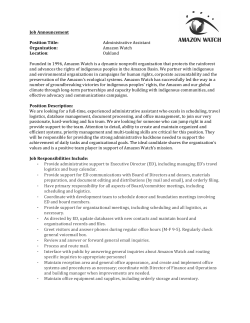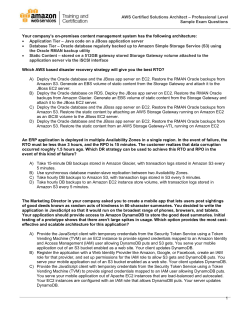
Amazon Web Services The Blue Book pages 19 onwards
Amazon Web Services The Blue Book pages 19 onwards References http://developer.amazonwebservices.com/ connect/forumindex.jspa An overview of AWS AWS is Amazon’s umbrella description of all of their web-based technology services. Mainly infrastructure services: ◦ ◦ ◦ ◦ ◦ Amazon Elastic Compute Cloud (EC2) Amazon Simple Storage Service (S3) Amazon Simple Queue Service (SQS) Amazon CloudFront Amazon SimpleDB Amazon EC2 is hiring ◦ http://aws.amazon.com/ec2-jobs/ Amazon EC2 EC2 provides web services API for provisioning, managing, and deprovioning virtual servers inside amazon cloud. Applications anywhere on the Internet can launch a virtual server in the amazon cloud with a single web services call (either REST or SOAP WS call) Where is SOAP API? For example, http://docs.amazonwebservices.com/AmazonEC2/dg/2006-06-26/using-soap-api.html Storage Instance –store : disappears with the instance (transient) Block storage: SAN-like, persists across time S3 is independent of an instance: for archival purposes: vault: store it now and retrieve it at a later date Amazon: SimpleDB: Relational database better than MySQl or Oracle for reliability. Amazon Cloud-front Cloud-based content distributing network enables you to place the content at the edges of the network for rapid delivery. Place the contents in S3 and run the application from anywhere and the content is moved to where the application is (to the edges). S3 Amazon web services API support the ability to: Find buckets and objects Discover their meta data Create new buckets Upload new objects Delete existing buckets and objects When manipulating the buckets you can optionally specify where they should be stored. Use REST API preferably something that abstracts out even that: Jets3t; s3cmd (command line) BitTorrent access to S3 is also available Bucket Naming Flat namespace Names may contain only lowercase letters, numbers, periods, underscores, and dashes, and must start with a number or letter Create your own namespace with your own bcukets EC2 concepts See figure 2.1 Instance: virtual server running a guest os of your choice AMI: Pristine image of your server so that you can launch any number of instance from this. Minimally machine image will operating systems + pre-installed tools. Elastic IP address: Not static not dynamic but elastic; an IP reserved for your use; disappears once the server is terminated. EC2 (contd.) Availability zone: Any two availability zones are guaranteed to share any common points of failure ( US, EU, Asia/Pacific) Security group: define the firewall/security. Defines what can talk to your instances. (Ex; http, and not sftp etc.) Snap shot: You can take snapshots of block volume (that can be formatted etc) and is stored in S3 for later use or for rollback etc. What is the difference between instances and machine images? How to access Ec2? AWS console http://console.aws.amazon.com The ElasticFox firefox plugin The amazon command line tool Typical Use in an organization Maintain a library of AMIs for the business ◦ May contain legacy systems or company-specific systems ◦ Harden AMIs using such software as Bastille Launch instances for non-technical but domain experts to work with. ◦ What will you provide them so that they can start working? Use S3 for archival storage and shared storage
© Copyright 2025





















